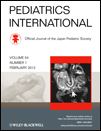Cord serum adiponectin is positively related to postnatal body mass index gain
Abstract
Background: The roles of adiponectin and leptin in the early stages of life are poorly understood. We previously studied longitudinal changes in these adipocytokines from birth to 12 months of age. The aim of this investigation was to evaluate the correlation between cord serum adipocytokine levels and postnatal growth by 3 years of age.
Methods: A questionnaire was sent to obtain the general physical measurements of 3-year-olds from 56 healthy newborn infants born at a gestational age of 35 weeks or more; 45 valid responses were obtained. The correlations between variables, including cord serum adipocytokine levels at birth and general physical measurements at 3 years, were investigated.
Results: Body mass index (BMI) Z-score gain from birth to 3 years was negatively correlated with birthweight SD scores (β=−0.395, P= 0.019) and gestational age (β=−0.557, P= 0.016), and positively correlated with cord serum adiponectin levels (β= 0.253, P= 0.043). BMI Z-score gain from birth to 6 months was negatively correlated with only birthweight SD score (β=−0.442, P= 0.017). Cord serum leptin levels were not a significant predictor of BMI Z-scores gain in our subjects. BMI Z-scores at 6 months, 12 months, and 3 years of age were not related to cord serum adiponectin or leptin levels.
Conclusions: Birthweight SD score, gestational age, and cord serum adiponectin levels are significant predictors of BMI Z-score gain from birth to 3 years of age in Japanese infants.




